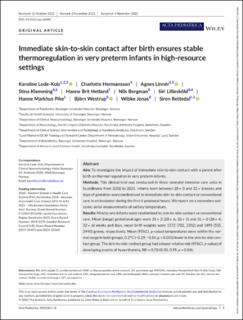| dc.contributor.author | Kolz, Karoline Lode | |
| dc.contributor.author | Hermansson, Charlotte | |
| dc.contributor.author | Linnér, Agnes | |
| dc.contributor.author | Klemming, Stina | |
| dc.contributor.author | Hetland, Hanne Brit | |
| dc.contributor.author | Bergman, Nils | |
| dc.contributor.author | Lilliesköld, Siri | |
| dc.contributor.author | Lillevik, Hanne Markhus | |
| dc.contributor.author | Westrup, Björn | |
| dc.contributor.author | Jonas, Wibke | |
| dc.contributor.author | Rettedal, Siren | |
| dc.date.accessioned | 2023-03-28T06:22:24Z | |
| dc.date.available | 2023-03-28T06:22:24Z | |
| dc.date.created | 2022-12-18T10:17:19Z | |
| dc.date.issued | 2022 | |
| dc.identifier.citation | Lode‐Kolz, K., Hermansson, C., Linnér, A., Klemming, S., Hetland, H. B., Bergman, N., ... & Rettedal, S. (2022). Immediate skin‐to‐skin contact after birth ensures stable thermoregulation in very preterm infants in high‐resource settings. Acta Paediatrica. | en_US |
| dc.identifier.issn | 0803-5253 | |
| dc.identifier.uri | https://hdl.handle.net/11250/3060631 | |
| dc.description.abstract | Aim
To investigate the impact of immediate skin-to-skin contact with a parent after birth on thermal regulation in very preterm infants.
Methods
This clinical trial was conducted in three neonatal intensive care units in Scandinavia from 2018 to 2021. Infants born between 28 + 0 and 32 + 6 weeks and days of gestation were randomised to immediate skin-to-skin contact or conventional care in an incubator during the first 6 postnatal hours. We report on a secondary outcome: serial measurements of axillary temperature.
Results
Ninety-one infants were randomised to skin-to-skin contact or conventional care. Mean (range) gestational ages were 31 + 2 (28 + 6, 32 + 5) and 31 + 0 (28 + 4, 32 + 6) weeks and days, mean birth weights were 1572 (702, 2352) and 1495 (555, 2440) grams, respectively. Mean (95%CI, p-value) temperatures were within the normal range in both groups, 0.2°C (−0.29, −0.14, p < 0.001) lower in the skin-to-skin contact group. The skin-to-skin contact group had a lower relative risk (95%CI, p-value) of developing events of hyperthermia, RR = 0.70 (0.50, 0.99, p = 0.04).
Conclusions
Very preterm infants, irrespective of clinical stability, do not develop hypothermia during immediate skin-to-skin contact after birth. Immediate skin-to-skin contact did protect against events of hyperthermia. Concerns about thermal regulation should not limit implementation of immediate skin-to-skin contact in high-resource settings. | en_US |
| dc.language.iso | eng | en_US |
| dc.publisher | Wiley | en_US |
| dc.rights | Navngivelse 4.0 Internasjonal | * |
| dc.rights.uri | http://creativecommons.org/licenses/by/4.0/deed.no | * |
| dc.title | Immediate skin-to-skin contact after birth ensures stable thermoregulation in very preterm infants in high-resource settings | en_US |
| dc.type | Peer reviewed | en_US |
| dc.type | Journal article | en_US |
| dc.description.version | publishedVersion | en_US |
| dc.rights.holder | The authors | en_US |
| dc.subject.nsi | VDP::Medisinske Fag: 700 | en_US |
| dc.source.pagenumber | 1-8 | en_US |
| dc.source.journal | Acta Paediatrica | en_US |
| dc.identifier.doi | 10.1111/apa.16590 | |
| dc.identifier.cristin | 2094762 | |
| cristin.ispublished | true | |
| cristin.fulltext | original | |
| cristin.qualitycode | 1 | |

